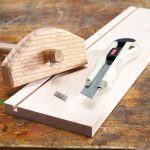We may receive a commission when you use our affiliate links. However, this does not impact our recommendations.
 Make a Sherpa of a dining table centerpiece that goes the distance.
Make a Sherpa of a dining table centerpiece that goes the distance.
The modest Lazy Susan is a staple on circular dining tables. Everyone can reach out and activate its convenient, if sluggish, spinning action in order to self-serve their favorite condiments from a jumble of bottles, shakers and jars.
The unseen glory of the Lazy Susan is a corral of ball bearings sandwiched between two metal plates underneath the deck. (With practice, a clever diner can generate enough velocity in the Lazy Susan’s rotation to create centrifugal force, which in turn will launch taller condiments on centripetal trajectories, usually culminating in a bad mess.)
Blast from the Passed
Sadly, the Lazy Susan is utterly lost on families who dine at long rectangular tables. Hardly anyone can reach the rotating platform and people must revert to asking each other to pass things. Where’s the fun in that?
So my unit, dubbed The Crazy Susan by the kinder members of the Popular Woodworking editorial staff, is built for bigger dreams.
No quiet, spinning elegance for this baby; it’s more of a raucous polka queen, able to traverse a 12-foot dining table in under a second with the grace of a Sherman tank. (The skill of the assembled diners determines whether the condiments stay onboard or succumb to kinetic entropy, also known as a bad mess.)
And thanks to the inverted roller balls, which carry up to 77 pounds each, we’re looking at a cumulative payload of 385 pounds. So yes, The Crazy Susan can double as a furniture dolly, plant pedestal, rock hauler, skateboard or ab roller.
Blank On It

In the round. The smoother your jigsaw cut, the less sanding.
Start by cutting a circular oak blank (about 11-1⁄2″ in diameter) using your jigsaw. Choose a robust blade, not a scrolling blade; this will give you a more perpendicular edge.
You might want to practice on a scrap of oak since jig-sawing hardwood can put you into a flop sweat. If you don’t advance the blade quickly enough the friction will char the wood, and if you really lean on the blade it will tend to flex and produce a bumpy or wobbly edge.
TIP: If you own a table saw, consider this alternative technique for cutting your blank: Google “Video, how to cut a circle on a table saw, George Berry”. It’s three minutes you’ll never regret, unlike that date I once had with a self-absorbed beat poet
Once you’ve cut your circular oak blank, sand the bumps out of the edge (this could take a while but it builds character).
Next, use a router to put an edge profile on the blank. First, attach a 3’x 3′ piece of plywood to the underside of your blank using three short screws. Then clamp at least two edges of the piece of plywood to a sturdy surface. Now you can easily rout around the edge of the blank in a counter clockwise direction.

Top down. Carve from the top of the tree to the roots to get natural-looking branches.
Carved for Attention
Inlay can be fun, even for beginners. You just need a rotary tool (e.g. a Dremel) and some nerve. I used an aggressive little cutting bit to carve my tree, but you might prefer a ballpoint bit. The higher the speed you select, the faster things get hairy. So start slowly and build confidence if not derring-do.
A fine artist once gave me a great tip for drawing trees; start in the sky and work down, pulling a line from the branch tip all the way to the root. You’ll get a much more organic and natural looking tree this way.
Carve each line to a depth of at least 1⁄16″ of an inch so that when you sand off the excess epoxy later, you’ll still have a design. (I learned that the hard way.)
If you don’t own a rotary tool, go old school with a micro V-gouge and a mallet, making sure to carve across the grain for easier progress.
Goo For It
Once you’re happy with your design, sand the surface with #120 grit to smooth the slivers and tear-out.
Then, using a page of an old phonebook as a disposable palette, mix a generous glop of 5-minute epoxy. Stir in a half-teaspoon or so of bronze powder (available in various hues at art supply stores).
Smear the tinted epoxy all over the surface of your oak blank using a paint scraper, spatula or cedar shingle depending on what’s handy, because by now the epoxy is starting to set up and you don’t have time to be fussy. Make sure to press the epoxy into all of the carved lines so there are no voids.
Let the epoxy cure overnight and then sand off all of the excess the next morning using an orbital sander and #100-grit sandpaper. Epoxy will have settled into the grain of the oak giving the un-carved portion of the surface lots of depth and character. Continue sanding up to #220 grit or higher to reveal the satiny, epoxy-filled inlay looking all perky and glorious.
Edge Your Bets
Next, hand-sand the routered edge of the blank. The edge will be insanely porous because oak’s grain is as open as the mouths of slack-jawed teenagers congregating in the 7-11 parking lot on a Friday night.

Gooey fun. Smear the tinted epoxy into the carved surface making sure to press it into all your carved lines. Now let it dry overnight.
To minimize the porosity, fill the edge-grain with water-based wood filler, which dries quickly. Once you sand off the excess wood filler, the edge will feel nice and smooth.
Before applying a clear finish, spray the whole piece with a light coat of water. This will raise the grain and the slivery little fibers will dry standing up, so you’ll have to sand it down once it’s dry. You may want to spray one more time after sanding, so that all of the rogue fibers rise now, rather than after you apply a water-based finish.
Apply at least one coat of finish to both sides and edges; I used MinWax WoodSheen.
Finally, drill pilot holes and then screw five transfer balls to the bottom of the unit (Lee Valley sells these as “roller balls”).
Under sedate circumstances, your Crazy Susan will transport your condiments reliably. And when you need a gurney to cart an incapacitated relative away from the dinner table, it’s nice to know that this Susan is never lazy.
PLAN: Download the free SketchUp plan for the Crazy Susan.
Here are some supplies and tools we find essential in our everyday work around the shop. We may receive a commission from sales referred by our links; however, we have carefully selected these products for their usefulness and quality.



 Make a Sherpa of a dining table centerpiece that goes the distance.
Make a Sherpa of a dining table centerpiece that goes the distance.




